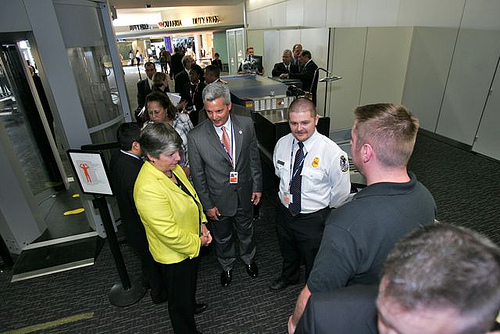Obama Requests $1 Billion to Protect the Airline Industry and Its Passengers in 2011
In its proposed 2011 budget for the Department of Homeland Security (DHS), the Obama Administration has requested nearly $1 billion to secure the nation's airports from terrorism-related threats on the heels of Christmas Day's botched attack by a young jihadist from Nigeria.
According to the 159-page document released yesterday, DHS requested a total of $8.2 billion for the Transportation Security Administration (TSA)—the agency responsible for protecting the nation's transportation system. The total 2011 request represents a discretionary increase of $508.7 million over the TSA's enacted budget this fiscal year
Nearly an eighth of the proposed amount will go to TSA's effort to protect passengers on domestic and international flights into and out of the United States. Domestically, $734 million will go to bolstering security at the nation's airports. Nearly a third of that proposed total is requested to buy 500 additional whole-body-imaging machines in 2011, which combined with DHS's plan to deploy 500 would put a total of 1,000 machines in the nation's highest-risk airports by next year.
"This appropriation will place this technology in 75 percent of the country's largest airports," said DHS' Peggy Sherry, acting chief financial officer, during a background briefing on the budget proposal with reporters on Monday.
Since the failure to detect the explosive powders sewn inside 23-year-old Umar Farouk Abdulmutallab's underwear before he boarded his Detroit-bound flight in Amsterdam, DHS has pushed aggressively for expanded deployment of whole-body scanners both domestically and internationally. Unlike pat-downs or traditional metal detectors, DHS believes whole-body scanners, which can peer underneath a passenger's clothes, would have detected the explosive powders Abdulmutallab smuggled through security on Dec. 25.
Explosives detection systems (EDS), which scan baggage for explosives, and explosives trace detection (ETD) technology also rank high on the TSA's list inside airports because of the Christmas Day plot. DHS wants to spend $374 million on EDS machines and $60 million to purchase 800 portable ETD devices.
An additional $71 million requested would fund 275 more explosive-sniffing K-9 teams at airline check points. The department also wants to increase the number of TSA behavior detection officers by 350 at a price tag of $20.2 million.
As part of the $125 million requested to promote international aviation security, the budget also requests $85 million to increase the amount of federal air marshals on international flights like the one Abdulmutallab boarded on Christmas Day. An additional $40 million would go to strengthen other international programs by increasing the number of personnel "strategically placed in high risk areas such as the Middle East and Africa," according to DHS budget document.
The budget request was delivered to Congress Monday along with the first ever Quadrennial Homeland Security Review. The document, modeled off of the Quadrennial Defense Review, is a strategic review that will guide DHS' policies, programs, and missions over the next four years.
According to The Washington Post, which obtained a copy of the document, it "shows the government's approach to homeland security continues to evolve away from a singular focus on terrorism." More so than the Bush administration, the Obama administration's idea of homeland security takes into fuller account the threat of natural disasters to homeland security, the Post reports.
The Obama administration's FY 2011 budget request for DHS totals $43.6 billion in discretionary spending, a 3 percent increase over the FY 2010 budget as enacted by Congress. Other FY 2011 budget request highlights include:
♦ $4 billion for state and local homeland security grant programs, a quarter of which will go to the Urban Area Security Initiative to protect high-risk cities like New York, Chicago, and Los Angeles.
♦ $1.4 billion to "recapitalize" the Coast Guard's fleet, including $538 million to build the fifth National Security Cutter.
♦ $379 million to develop the National Cyber Security Division, which will work to protect the .gov and .com domain name systems from cyberattack.
♦ $103.4 million for E-Verify, which helps employers check whether a prospective employee is a legal citizen.
♦ $287.8 million to complete and open a new DHS headquarters at the St. Elizabeth's campus in Washington, D.C.
